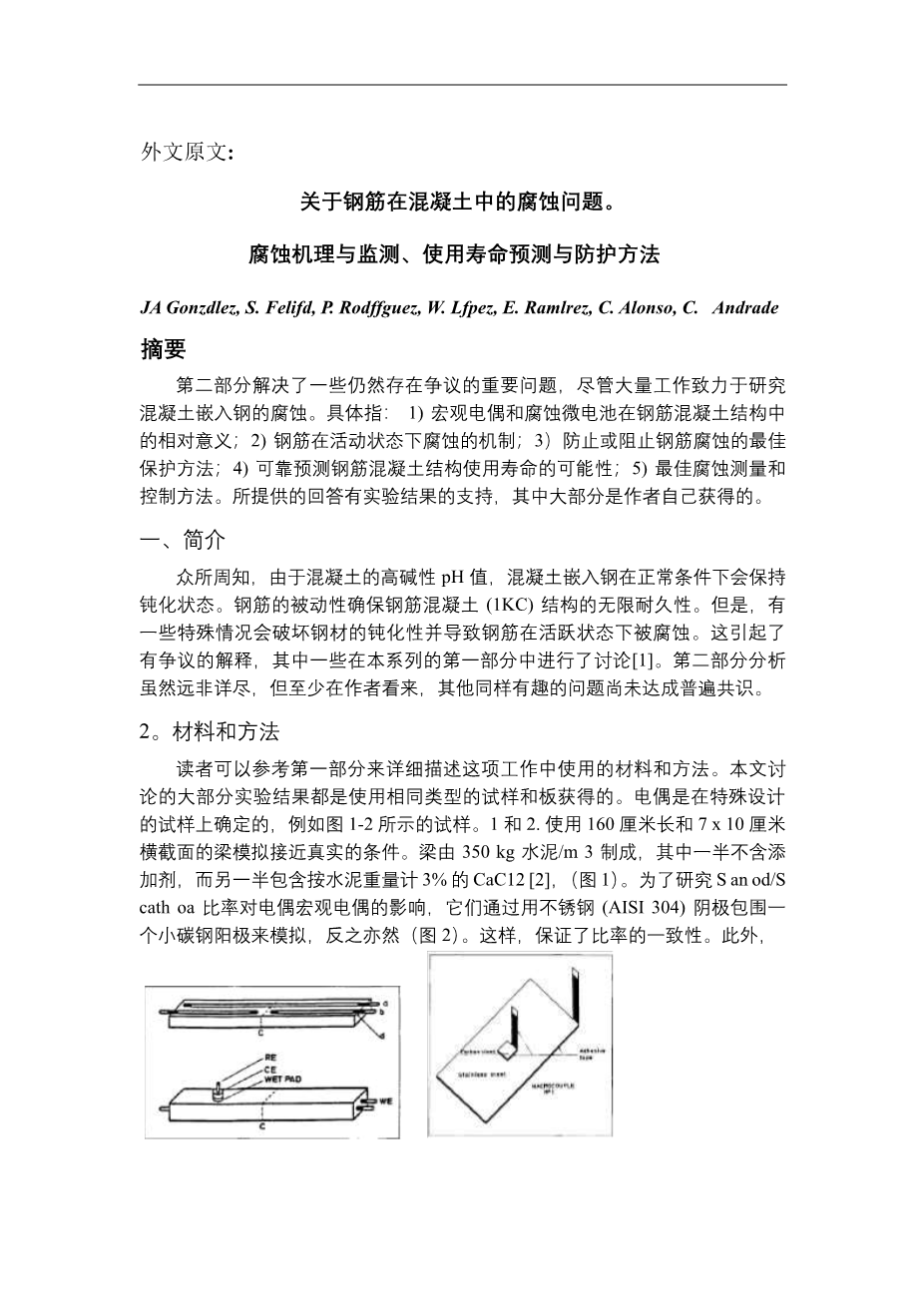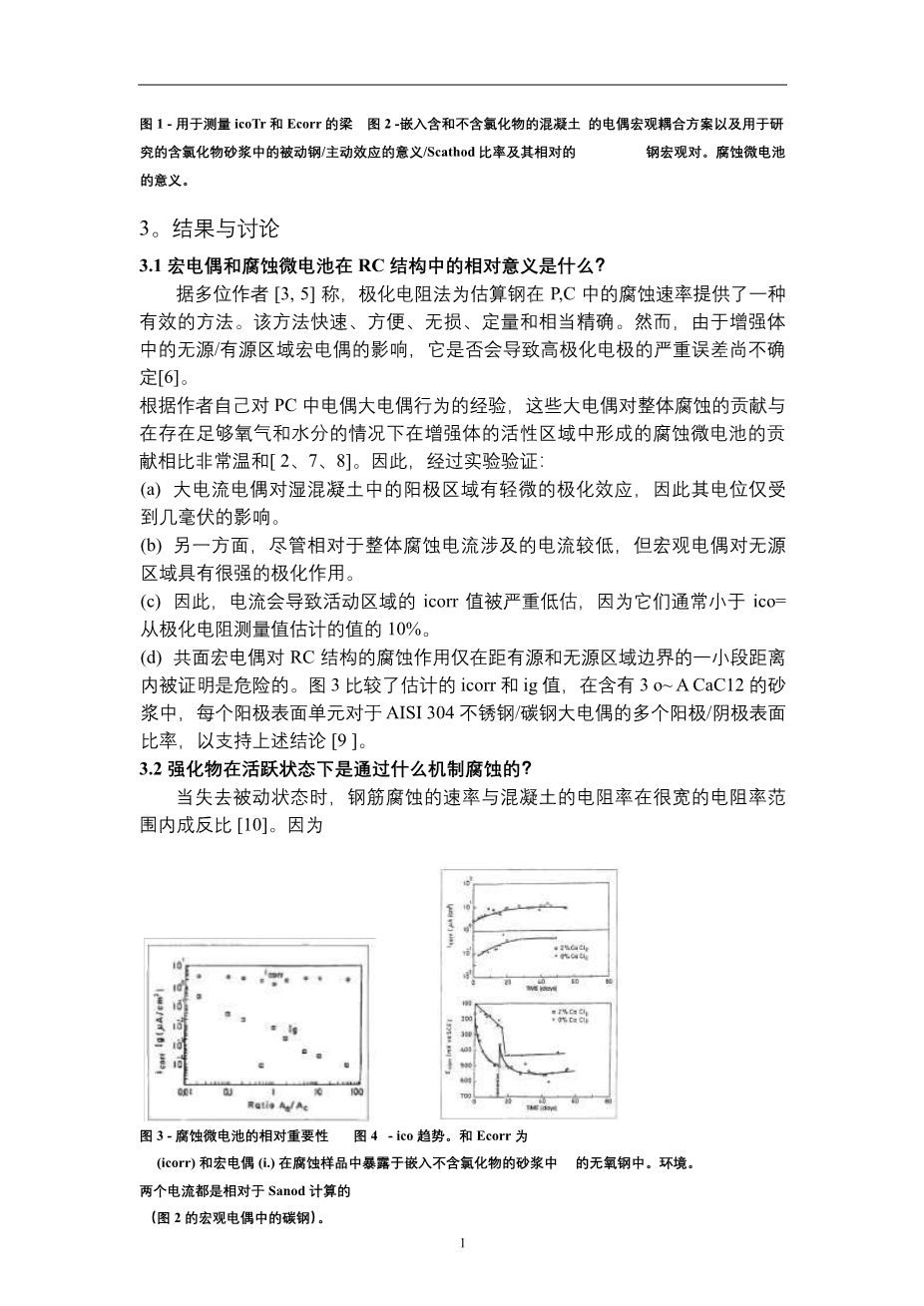关于钢筋在混凝土中的腐蚀问题。腐蚀机理与监测、使用寿命预测与防护方法外文翻译资料
2023-06-25 09:55:58
外文原文:
Some questions on the corrosion of steel in concrete.
Corrosion mechanism and monitoring, service
life prediction and protection methods
J.A. Gonzdlez , S. Felifd, P. Rodffguez , W. Lfpez , E. Ramlrez , C. Alonso , C.
Andrade
ABSTRACT
This second part addresses some important issues that remain controversial despite the vast amounts of work devoted to investigating corrosion in concrete-embedded steel. Specifically,these refer to: 1) the relative significance of galvanic macro couples and corrosion micro cells in reinforced concrete structures; 2) the mechanism by which reinforcements corrode in an active state; 3) the best protective methods for preventing or stopping reinforcement corrosion; 4) the possibility of a reliable prediction of the service life of a reinforced concrete structure ; and 5) the best corrosion measurement and control methods. The responses provided are supported by experimental results, most of which were obtained by the authors themselves.
1. INTRODUCTION
Concrete-embedded steel is known to remain in a passive state under normal conditions as a result of the highly alkaline pH of concrete. The passivity of reinforcements ensures unlimited durability of reinforced concrete (1KC) structures. However, there are some exceptional conditions that disrupt steel passivity and cause reinforcements to be corroded in an active state. This has raised controversial interpretations, some of which were discussed in Part I of this series [1]. This Part II analyses though far from exhaustively, other - to the authors minds at least - equally interesting issues on which no general consensus has been reached.
2. MATERIALS AND METHODS
The reader is referred to Part I for a detailed description of the materials and methods used in this work. Most of the experimental results discussed herein were obtained with the same types of specimens and slabs.Galvanic couples were determined on specially designed specimens, such as those shown in Figs. 1 and 2.Near-real conditions were simulated by using a beam that was 160cm long and 7 x 10 cm in cross-section. The beam was made from 350 kg cement/m 3, half of which
contained no additives, while the other half included 3% CaC12 by cement weight [2], (Fig. 1). In order to study the effect of the S an o d/ S cath oa ratio on galvanic macro couples, they were modeled by surrounding a small carbon steel anode with a stainless steel (AISI 304) cathode and vice versa (Fig. 2). In this way, the ratios consistency was assured. In addition, the potential and icorr of stainless steal and those of the passive structures were very similar.
Fig. 1 - Beam used to measure icoTr and Ecorr in Fig. 2 - Scheme of galvanic macro couples embedded
concrete with and without chlorides and to in chloride- containing mortar used to study the
illustrate the significance of passive steel/active effect of the Sanod/Scathod ratio and their relative
steel macro couples. significance to corrosion micro cells.
3. RESULTS AND DISCUSSION
3.1 What is the relative significance of galvanic macro couples and corrosion
Micro cells in RC structures ?
According to several authors [3, 5], the polarization resistance method provides an effective means for estimating the corrosion rate of steel in P,C ; the method is quite rapid, convenient, non-destructive, quantitative and reasonably precise. However, it is uncertain whether it may give rise to serious errors with highly-polarized electrodes by the effect of passive/active area galvanic
macrocouples in the reinforcements [6].
Based on the authors own experience with the behaviour of galvanic macrocouples in PC, the contribution of these macrocouples to overall corrosion is very modest rehtive to that of the corrosion microcells formed in the active areas of reinforcements in the presence of sufficient oxygen and moisture [2, 7, 8]. Thus, it has been experimentally checked that:
(a) Galvanic macrocouples have a slight polarizing effect on anodic areas in wet concrete, whose potential is thereby influenced in only a few millivolts.
(b) On the other hand, macrocouples have a strong polarizing effect on passive areas despite the low galvanic currents involved relative to the overall corrosion current.
(c) As a result, galvanic currents can result in grossly underestimated icorr values for the active areas since they are often smaller than 10% of the ico= values estimated from polarization resistance measurements.
(d) The corrosive effect ofcoplanar macrocouples on RC structures only proves dangerous within a small distance from the boundary of active and passive areas.
Fig. 3 compares the estimated icorr and ig values, in mortar containing 3 o~ A CaC12, per anode surface unit for a number of anode/cathode surface ratios for AISI 304 stainless steel/carbon steel macrocouples in support of the above conclusions [9].
3.2 By what mechanism do reinforcements corrode in an active state ?
When the passive state is lost, the rate of reinforcement corrosion in inversely proportional to the resistivity of concrete over a wide resistivity range [10]. Because
Fig. 3 - Relative significance of corrosion microcells Fig. 4 - Trends in ico. and Ecorr for
(icorr) and galvanic macrocouples (i.) in corrosion specimens exposed to an oxygen-free
of steel embedded in mortar containing no chloride. environment.
Both currents
剩余内容已隐藏,支付完成后下载完整资料


英语译文共 4 页,剩余内容已隐藏,支付完成后下载完整资料
资料编号:[603526],资料为PDF文档或Word文档,PDF文档可免费转换为Word




